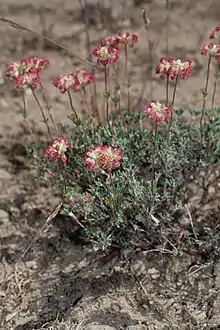Eriogonum thymoides
Eriogonum thymoides is an "abundant"[1] species of flowering plant in the buckwheat family known by the common name thymeleaf wild buckwheat, or simply thymeleaf buckwheat.
| Eriogonum thymoides | |
|---|---|
 | |
| Scientific classification | |
| Kingdom: | Plantae |
| Clade: | Tracheophytes |
| Clade: | Angiosperms |
| Clade: | Eudicots |
| Order: | Caryophyllales |
| Family: | Polygonaceae |
| Genus: | Eriogonum |
| Species: | E. thymoides |
| Binomial name | |
| Eriogonum thymoides | |
It is native to Idaho, Oregon, and Washington in the Pacific Northwest of the United States, where there are three main population groups.[2]
This plant grows in sagebrush, ponderosa pine forest openings, and mountain ridges.[1]
This is a subshrub up to 30 by 40 centimeters wide and covered in woolly or silky hairs. The hairy leaves are linear to spatulate and flat or rolled, and measure up to 1.5 centimeters in length. It produces erect flowering stems up to about 12 centimeters tall. Each stem has a whorl of small bracts around the middle. Atop the stem is a headlike inflorescence up to 2 centimeters wide. The flower is up to a centimeter long and white to yellow to pink in color. The species is polygamodioecious, meaning some of the plants have both male and bisexual flowers, while others have both female and bisexual flowers.[2]
This plant has "special value to native bees."[3]
References
- Eriogonum thymoides. Washington Burke Museum.
- Eriogonum thymoides. Flora of North America.
- Eriogonum thymoides. Lady Bird Johnson Wildflower Center.
External links
| Wikimedia Commons has media related to Eriogonum thymoides. |
| Wikispecies has information related to Eriogonum thymoides. |